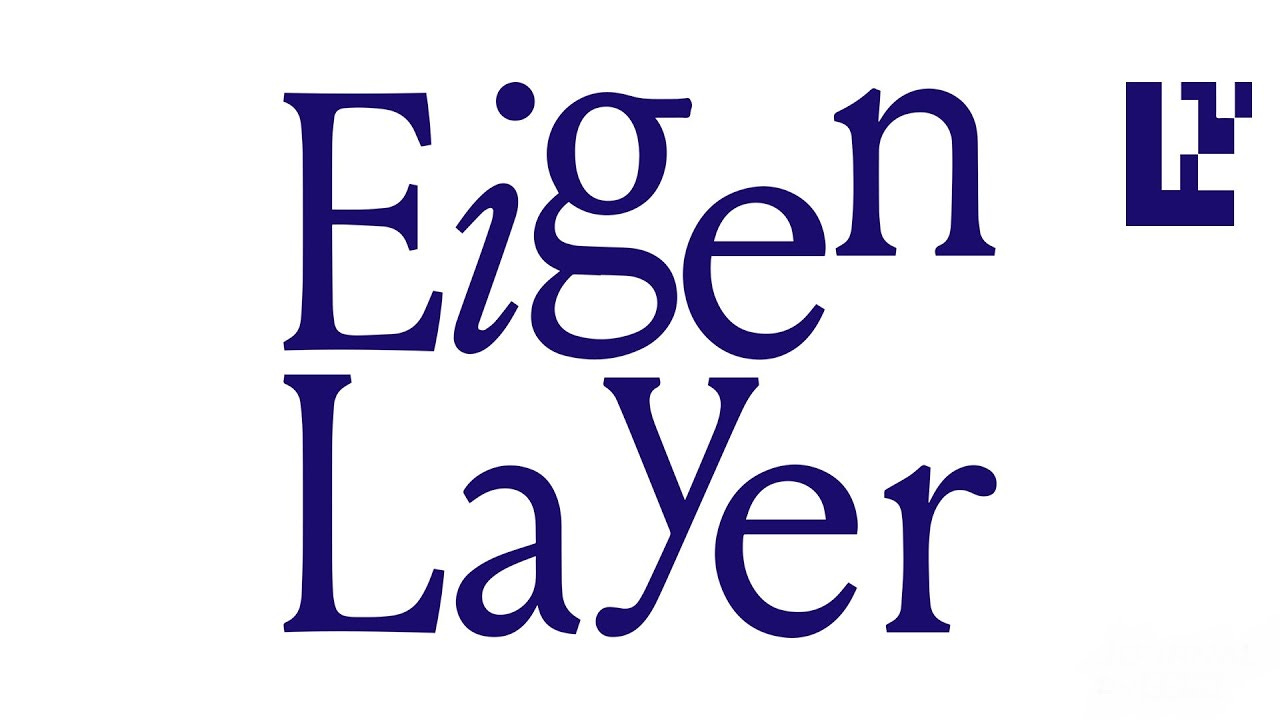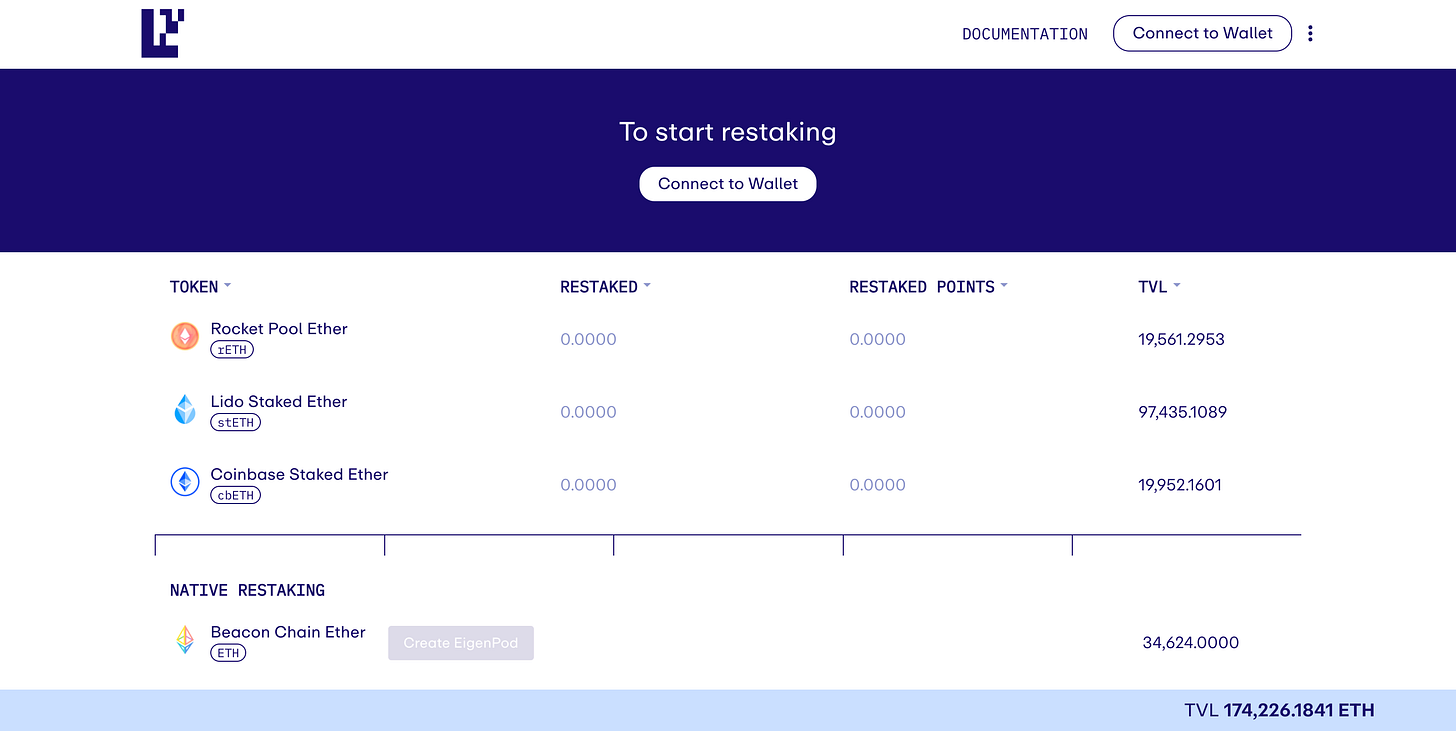Restaking: a new Primitive
This short article investigates restaking, a new primitive that has captured the attention of builders, spotlighting the case study of EigenLayer.
EigenLayer is a unique protocol that enables ETH stakers to restake their Ethereum across multiple networks simultaneously.
For this discussion, I’ll focus on the “restaking” feature of EigenLayer, outlining its attributed, risks, and the use cases it opens up.
Let’s start from the beginning, what is restaking?
Restaking is the idea that the same stake used to secure the Ethereum PoS, can now be used to secure many other networks.
It opens Pandora’s box to repurpose the army of stakers protecting Ethereum to protect other blockchains.
In practice, restaking can be interpreted as programmable staking, where users opt-in any set of positive or negative incentives to secure other infrastructure.
Would you Eth staker, like to opt into additional
slashing conditions on other chains?
This of course translates into additional risk for stakers.
Why would anyone do this?
Simply put it, because of economic incentives and yields.
If Ethereum staking yields hover around 5% annually, restaking could offer an enticing additional yield.
It’s not currently possible to provide a correct estimate as it will be decided by demand and supply dynamics on the Eigen Marketplace.
EigenLayer
At its core, Eigenlayer is a series of smart contracts interacting natively with staking. It offers two forms of restaking:
Native Restaking: where Ethereum stakers restake their staked ETH natively by pointing their withdrawal credentials to the EigenLayer contracts.
LST Restaking: where LST holders restake their Liquid Staking Tokens (LSTs) by transferring them into the EigenLayer smart contracts.
When you opt-in to restake your tokens, you are essentially entrusting to the EigenLayer contracts the authority to slash your stake or incentivize you through rewards.
The way EigenLayer works is by adding an additional step to the withdrawal flow of staking:
Instead of funds directly reaching your wallet, they are routed to a smart contract. This contract, which is party under your control, entrusts slashing power to EigenLayer. After this step is carried out, you can withdraw the funds to your wallet.
This is necessary for EigenLayer to impose penalties or slash collateral in case of malicious actors.
Selling Trust
Ethereum’s PoS serves as a decentralized trust mechanism. EigenLayer allows others to “rent” a portion of this trust, hence why it can also be understood as a “marketplace for raw decentralized trust”.
For a thought exercise you can compared this process to how Ethereum lends its security to provide block space to anyone willing to use it.
EigenLayer is “modularizing” the decentralized trust of Ethereum so that projects can leverage it and use it instead of building it from scratch.
Typically, such modules require actively validated services that have their own distributed validation semantics to do verification. Usually, these actively validated services (“AVS”) are either secured by their own native token, or are permissioned in nature.
As such, EigenLayer can supply economic trust (in the form of staked eth), so that anything objectively verifiable can be slashed.
However, the Ethereum trust model is not only about money (secured by staked Eth) but also about collusion resistance. This is because money only allows you to slash for “objective violations” (e.g. double spending), but people could collude in different ways which are not always objective: how do we know inside the blockchain that some malicious actor has excluded some event from the chain? To counter this, we need block producers to be diverse - to integrate different perspectives into block production and reduce the possibility of collusion (and increase decentralization).
In the case of EigenLayer, it introduces a 7-day lag in withdrawal to allow its Slashing Veto Committee (as internal social consensus), to solve illegitimate slashing, such as bugs in slashing contracts.
What can we build with EigenLayer?
The EigenLayer infrastructure can be considered a playground where Ethereum Improvement Proposals get tested out before ending up on mainnet. As the development pace is higher in the private sector, Eigen already brings about similar developments to what we’ll soon see on the mainnet.
An example of it is EigenDA, a data availability solution that has more than 10 MB per second of bandwidth (this is much more than Ethereum will have after danksharding is implemented on mainnet).
R(isk)-Staking
For stakers, restaking means that you can decide to opt-in to as many networks as you wish, and boost your yields, hence why EigenLayer refers to itself as “the Airbnb of decentralized trust”.
It’s not all roses though.. as restaking adds some notable risks:
ETH must be staked (or LSTs - hence not liquid)
EigenLayer smart contract risk
Protocol-specific Slashing conditions
Furthermore, the Ethereum Developer community has also raised issues with regard to Restaking, notably in the famous Vitalik article about not overloading Ethereum consensus. The issue with restaking is that it opens up new avenues of risk for staked Eth that secures the mainnet, it destines a part of it to secure other chains (as opted-in by stakers). As a consequence, if they misbehave according to other protocol rules (which could have bugs or weak security), their deposit gets slashed.
The debate is very actual with the devs and EigenLayer trying to find a way to coordinate efforts and make sure that Ethereum is not weakened by these technical advancements.
All in all, Restaking is an interesting new primitive worth researching.
The concerns of Vitalik and others are not to be minimized and whenever we talk about restaking it’s important to bear in mind how this really affects mainnet.
EigenLayer Benefits:
Alleviating the capital cost of security (no fighting for capital, but cooperation and resource sharing)
Eth stakers can increase their profits by staking on more chains
Projects no longer need to offer aggressive staking pools during bootstrapping, reducing the cost burden
New mechanism for pool security: cost of corruption can go up 10x compared to no EigenLayer
Cheaper and wider bandwidth
Attracts more capital into Eth ecosystem to take advantage of extra yield
Increases interoperability of eth
Increases security for protocols that can leverage mainnet by using eigenlayer
Reduce the capital cost of protocols bootstrapping validator set
EigenLayer Risks:
Collusion risk, many operators could attack a set of Avs at the same time and compromise security
Slashing risk: users restaking are subject to slashing penalties from both ETH and Avs
Single point of failure: receives withdraw credentials from eth credentials (systemic risk for mainnet)
Centralization risk for validators
Adds additional risks to the stake securing Ethereum
Key Takeaways
EigenLayer is a middleware built on the Ethereum network to commoditize decentralized trust.
Protocols have lower cost barriers to kick-start when they are able to leverage Ethereum’s highly robust security layer.
EigenLayer offers an alternative off-chain data availability option to Layer 2s, enabling them to save on the data management cost while providing a similar level of security.
Users benefit from increased capital efficiency by having the option to restake their ETH, in turn receiving more staking rewards
Given what we have mentioned, EigenLayer does not intend to compete with L2s but rather become a complementary tool (for developing bridges, oracles etc.)
Restaking is an exciting primitive that can spur a novelty of use cases.
While full development of the Eigen marketplace will take place in about a year, there are already a few interesting restaking experiments being explored.
Some concerns raised by Vitalik are related to the centralization of staking power, as well as the disincentivization of solo staking.
It will be interesting to observe how EigenLayer will team with the Ethereum Foundation to address those.
More writing on EigenLayer:
Eigen Settlement: https://twitter.com/zerokn0wledge_/status/1703716188080189577
Eigen Data Availability Layer: https://twitter.com/zerokn0wledge_/status/1663213715486031873
EigenLayer Intro: https://twitter.com/0xTindorr/status/1682047097275842564
Restaking: https://twitter.com/0xAndrewMoh/status/1704788492088471912
EigenLayer: https://twitter.com/100y_eth/status/1613548890602770432






